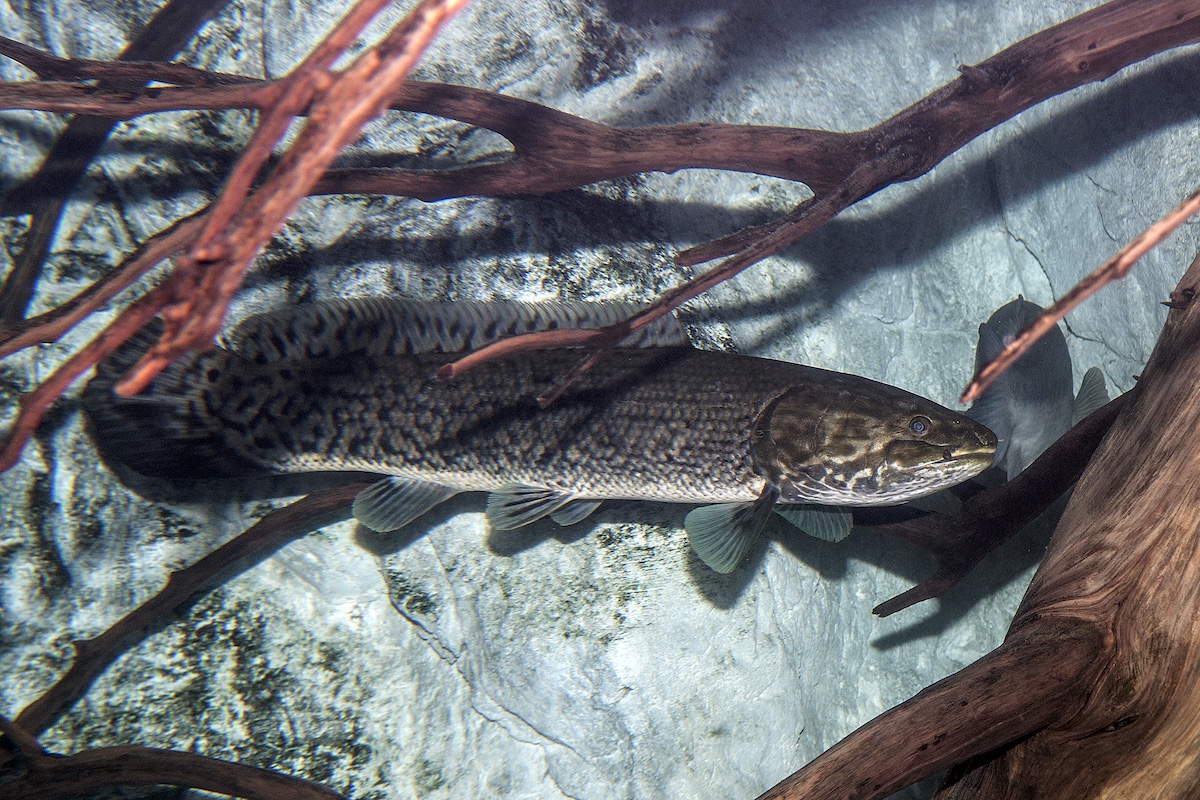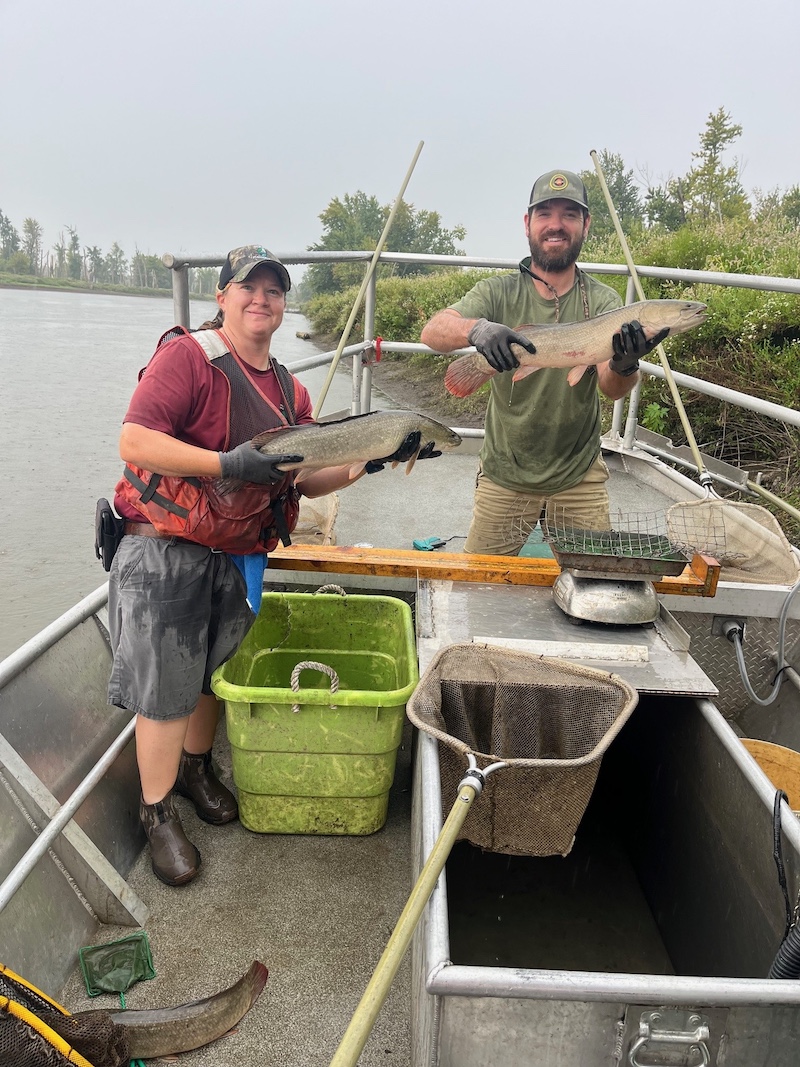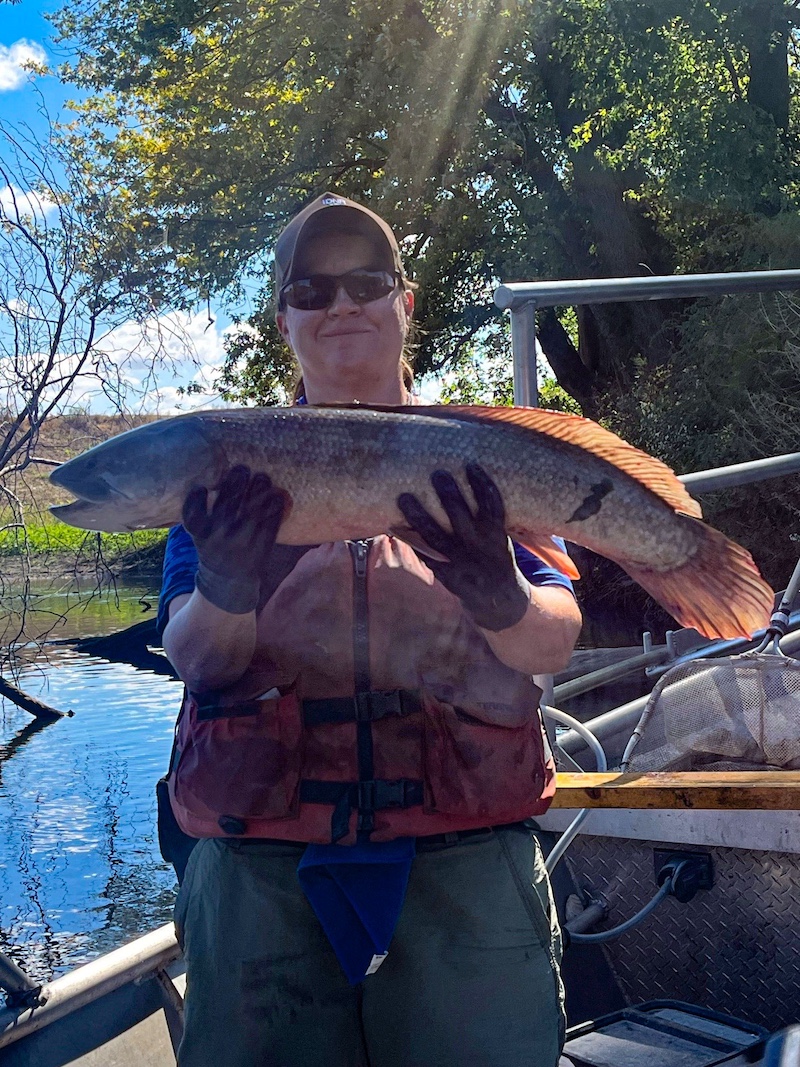
Bowfin hiding under tree branches. Photo by Michelson Fish Photography.



Bowfin hiding under tree branches. Photo by Michelson Fish Photography.
Step into a backwater slough or a quiet oxbow off one of Illinois’ big rivers, and you may find yourself face-to-face with a fish that has outlasted the dinosaurs. The bowfin (Amia calva), sometimes called “dogfish,” “grinnel” or even “mudfish,” is one of the most ancient species swimming in North America’s waters. While often overlooked by anglers in pursuit of bass, crappie or catfish, the bowfin is a vital predator, a fascinating study in evolutionary history, and—more recently—a fish gaining respect among Illinois’ conservation community.

Bowfin belong to a lineage dating back more than 150 million years, making them what biologists often call “living fossils.” They are the last surviving member of the family Amiidae, once widespread across the globe. Today, their range is confined to the eastern half of North America, with Illinois squarely in the heart of prime bowfin country.
The fish itself resembles something from prehistory. Long, cylindrical and powerfully built, the bowfin carries a single continuous dorsal fin stretching nearly half its back. Males are often marked by a distinctive black spot near the tail, sometimes ringed in orange. Their broad, bony heads house rows of sharp teeth—tools designed for ambush predation in murky backwaters. When hooked, they fight with dogged strength, thrashing and rolling in a way that has earned them both admiration and frustration from anglers.
Unlike most modern fish, bowfin possess a modified swim bladder that functions like a lung, allowing them to gulp air at the surface. This adaptation helps them thrive in sluggish, oxygen-poor waters where other species struggle. It’s one of many traits that have allowed bowfin to endure while countless other lineages vanished into extinction.
Bowfin favor quiet, weedy environments. You’ll find them in the floodplain lakes of the Mississippi and Illinois rivers, in oxbows along the Kaskaskia River, in cypress-tupelo sloughs of the Cache River basin, and in countless smaller backwaters across the state. They are equally at home in the shallow margins of large reservoirs and in smaller lakes with healthy aquatic vegetation.
Their preference for slow, vegetated waters sometimes places them in conflict with modern land use. Wetland drainage, levee construction and loss of backwater habitat all take a toll. Yet, despite these pressures, bowfin remain surprisingly resilient across Illinois, maintaining healthy populations wherever wetlands and backwaters persist.

For much of the 20th century, bowfin were maligned as “trash fish.” Anglers frequently killed them under the belief that they harmed sport fish populations. In reality, bowfin are opportunistic predators that primarily consume forage fish such as shad, minnows and sunfish, along with crayfish, frogs and other small aquatic creatures. Far from being destructive, they play a crucial role in balancing ecosystems by regulating the populations of smaller species.
Recent studies in Illinois and neighboring states have reinforced the ecological importance of this phenomenon. Bowfin fill a niche similar to that of northern pike or largemouth bass in many systems, especially in shallow wetlands where those species are less common. By exerting top-down pressure on prey communities, bowfin contribute to healthier, more diverse aquatic ecosystems.
“If you find a decent population of bowfin, that’s a sign that you have a pretty healthy ecosystem going,” said Matt O’Hara, the Mississippi River Biologist with the Illinois Department of Natural Resources’ (IDNR), Division of Fisheries and based in the Havana Field Office.
Though overlooked in the past, bowfin are increasingly recognized for their sporting value. Hook into one on medium spinning tackle, and you’ll quickly understand why. They strike aggressively, bulldog with immense power, and often leap or roll in spectacular attempts to throw the hook. Anglers who target them intentionally praise their fight as equal to or greater than that of bass of similar size.
Illinois bowfin regularly exceed 24 inches in length and specimens topping 30 inches are not uncommon. The state record, taken in 1981 from a Fulton County surface mine lake, weighed 16 pounds, 6 ounces. While bowfin are edible, their soft, highly perishable flesh is less popular than that of catfish or walleye. Some anglers smoke or pressure-can the meat, but most release their catch to fight another day.
Unlike many native fish, bowfin are not currently threatened or endangered in Illinois. They remain relatively common in suitable habitats. However, ongoing pressures from wetland loss, invasive species and water quality issues warrant continued monitoring.
IDNR does not manage bowfin as a game species in the same manner as bass, crappie or walleye; however, fisheries biologists are increasingly aware of their ecological value. Bowfin are included in surveys and monitoring efforts, particularly in floodplain systems where they can serve as indicators of wetland health. According to O’Hara, there have been a few instances where bowfin have been restocked following habitat management work. O’Hara explained that not only does that give a jump start to healthy habitat, it’s also in response to stakeholder requests.
Interestingly, bowfin have also become the focus of commercial interest. Their roe is marketed internationally as a caviar substitute, sometimes referred to as “choupique caviar.” In southern states, such as Louisiana, bowfin roe fisheries have experienced significant growth. While Illinois does not currently support large-scale harvest, the trend highlights the need for balanced management to ensure populations remain sustainable.
For many Indigenous peoples, bowfin held cultural significance. Archaeological evidence indicates that the bones and scales of these fish were used in tools and ornaments, while the fish itself provided food. Today, bowfin continue to occupy a place in local folklore. Anglers across Illinois tell stories of dogfish tearing up tackle, spitting lures or surfacing in eerie gulps of air on a quiet summer evening.
To some, bowfin embody the wild resilience of Illinois’ waters—survivors of an ancient world that endure alongside us in the present.
As Illinoisans grow more attuned to the value of native biodiversity, the bowfin is beginning to get its due. What was once dismissed as a nuisance is now appreciated as a living link to prehistory, a fierce fighter on rod and reel, and an essential part of healthy wetland ecosystems.
For outdoor enthusiasts, bowfin offer a chance to connect with a piece of the state’s natural heritage that is both ancient and immediate. Whether encountered by accident while bass fishing a weed-choked lake or sought intentionally in the quiet backwaters of the Mississippi, the bowfin challenges us to rethink what makes a fish “worthy.”
Next time you see that broad, prehistoric head break the surface for a gulp of air, consider this: you’re sharing the water with a species that swam when Illinois was covered in shallow seas and dinosaurs still ruled the earth. Few encounters in the outdoors can so vividly collapse the distance between past and present.
If there’s one message that O’Hara had for Illinois anglers, it is that bowfin are a valuable native fish that helps to keep ecosystems healthy and thriving.
“Through lots of grassroots efforts, we are just scratching the surface of getting the message out – these aren’t what many consider ‘trash fish’ or a threat to their sport fishing success,” he explained. “Bowfin are a fascinating native species.”
If you’re lucky enough to hook one, hang on tight. You’ve just tied into one of the oldest fighters in North America.
Gretchen Steele hails from Coulterville. Steele is a freelance outdoor communicator. Her award-winning work appears as a regular columnist and contributing feature writer for Illinois Outdoor News and several Illinois newspapers. She enjoys spending her time afield as a volunteer for the Illinois Department of Natural Resources, Delta Waterfowl Foundation, Retrievers Unlimited, and various other conservation organizations. Steele is a member of the Illinois Conservation Federation Outdoor Hall of Fame. She is the Past President of Missouri Outdoor Communicators and remains an active member. Steele is a current and active member and formerly served on the Board of Directors with Association of Great Lakes Outdoor Writers.
Submit a question for the author